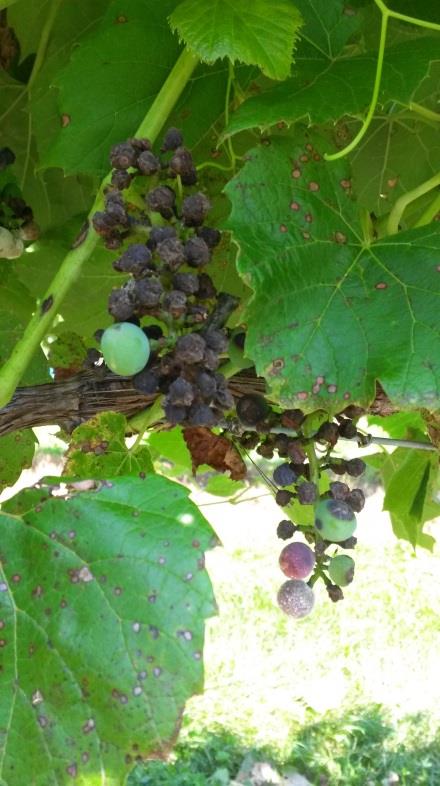Reducing Disease Pressure through Vineyard Sanitation
As we approach the beginning of another growing season, a yearly concern to growers is the challenge of controlling disease. While there are elements of disease development each year that growers cannot control, we can reliably get a start on minimizing disease pressure during the off-season by implementing vineyard sanitation practices.
What is vineyard sanitation?
Vineyard sanitation is the practice of removing and destroying prunings, diseased wood, and diseased berries from a vineyard each year. Mulching or cultivating can also be employed to encourage decomposition and avoidance of overwintering fungal structures.
Why is vineyard sanitation so important?
There are several damaging grape diseases that rely heavily on infected tissues from the previous year to initiate new infections each spring. Leaving infected prunings or berries in a vineyard serves as a source of inoculum (spores), leading to heightened problems throughout the season. These fungi produce special overwintering structures that house their sexual or asexual spores, and if left in the vineyard these structures will release spores for several weeks during the growing season. By removing these structures during the offseason, we prevent this steady release of spores onto the developing crop each year.
What are some of the diseases that can be reduced by practicing good vineyard sanitation?

Black Rot (Guignardia bidwellii) overwinters in desiccated grape berries, called “mummies” which remain on the rachis attached to the previous year’s growth through the winter months, as well as in infected canes. Infected tissues are filled with flask shaped structures containing either asexual or sexual spores. Spores are discharged when warm spring weather arrives, and are splashed onto young growth during rain events. Young stems, leaves, and flowers are highly susceptible to infection.
Phomopsis Cane and Leaf Spot (Phomopsis viticola) overwinters in a similar fashion to black rot. Like black rot, phomopsis turns infected fruits into mummies filled with sexual and asexual spores during the growing season, and can also infect canes. Mummies may hang on the rachis of infected clusters throughout the winter or fall to the ground. In the spring of each year, spores are splashed onto susceptible young foliage, flowers, and fruit during rain events.
Anthracnose (Elsinoë ampelina) overwinters primarily in infected canes. Mummified berries that fall to the vineyard floor and overwinter have also been documented, and may contribute to disease outbreaks. Sexual and asexual spore structures are found on both infected fruit and cane tissue. Like black rot and phomopsis, spores are splashed onto new tissues in the spring during rain events.
Additional points on vineyard sanitation:
Diseases such as black rot, phomopsis, and anthracnose are reduced through vineyard sanitation because they rely heavily on splashing rain to distribute spores from overwintering structures that are already present within the vineyard. Diseases such as powdery mildew and downy mildew are not as effectively controlled by vineyard sanitation in the same way because of their windblown spores, which are able to travel long distances in large numbers and cause severe outbreaks. While spores of black rot, phomopsis, and anthracnose are capable of travelling short distances, they do not have the same capacity to move in wind currents, accumulate, and cause outbreaks in a single season. For this reason, diseases such as black rot, phomopsis, and anthracnose are said to have a cumulative effect. This means neglecting control of these pathogens will result in significant increases in disease pressure in each successive year. This contrasts with diseases such as powdery mildew and downy mildew, which can cause devastating outbreaks in a single season if not properly managed.
This is an excellent time of year to walk through your vineyard and remove withered clusters still hanging on cordons and make sure that prunings have been destroyed. A layer of mulch or investment in cultivation will further reduce inoculum. Make sure to pair good vineyard sanitation practices with well-timed sprays early in the season. Good vineyard sanitation and well-timed product application provide an excellent start to a productive year.
This article was posted in Disease, WFN, Vol. 1-4 and tagged David S. Jones, disease, Grapes, Patty McManus, vineyard sanitation.
